Operation Polo 1948 stands as a pivotal chapter in the history of India, marking the dramatic annexation of Hyderabad, a princely state of immense cultural and political significance. This historical event, which unfolded in September 1948, was a critical juncture in India’s journey towards unification and independence. Before 1948, Hyderabad held a unique status as one of the largest princely states, with its own administration, currency, and a rich tapestry of cultures coexisting within its borders. However, Operation Polo changed the course of history, reshaping the map of India and cementing the country’s commitment to unity in diversity.
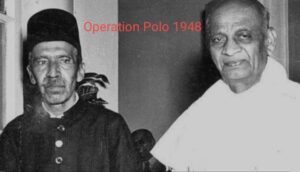
1. Operation Polo 1948 : Historical Context
• Provide background information on the Nizam of Hyderabad.
The Nizam of Hyderabad, officially known as the Nizam-ul-Mulk of Hyderabad, was the title held by the ruling monarch of the princely state of Hyderabad. Before delving into Operation Polo and its historical significance, it’s crucial to understand the background of the Nizam and the princely state.
The Nizam ruled over Hyderabad, a princely state located in the southern part of India. Hyderabad was unique among princely states because of its size, wealth, and semi-autonomous status within British India. The Nizam enjoyed significant political and administrative authority within his state, which covered a vast geographical area.
The Nizame of Hyderabad was founded in the early 18th century when the Mughal Empire was in decline. The first Nizam, Mir Qamar-ud-din Khan, was appointed as the governor of the Deccan region by the Mughal Emperor. Over time, the Nizams of Hyderabad established their independent rule and became known for their opulence and grandeur. They maintained a unique cultural and administrative identity, distinct from the British colonial administration.
Before the events of Operation Polo in 1948, the Nizam, Mir Osman Ali Khan, was one of the wealthiest individuals in the world. He ruled Hyderabad from 1911 until the state’s annexation in 1948. Hyderabad was known for its religious and cultural diversity, with a substantial Hindu and Muslim population, among others, living harmoniously.
However, the Nizam’s relationship with the newly independent Indian government, led by leaders like Sardar Patel, was fraught with tension due to political and ideological differences. This friction ultimately culminated in Operation Polo, a military campaign that integrated Hyderabad into the newly formed Republic of India in September 1948. This integration marked a significant turning point in India’s India’s post-independence history and was a crucial step towards the nation’s unity.
• Explain the princely state’s semi-autonomous status.
The semi-autonomous status of princely states in British India was a unique feature of the colonial administration, which allowed these states a degree of self-governance while still acknowledging the overall sovereignty of the British Crown. Here’s an explanation of the princely state’s semi-autonomous status:
1.Suzerainty of the British Crown: Princely states were technically sovereign entities with their rulers, often referred to as “Maharajas” or “Nizams,” exercising significant authority within their territories. However, they were not fully independent nations. Instead, they acknowledged the suzerainty (supreme authority) of the British Crown.
2.Local Autonomy: Princely states enjoyed a considerable degree of local autonomy. They had their governments, administrations, legal systems, and even their armies. The rulers had the power to make laws, levy taxes, and administer justice within their territories.
3.British Paramountcy: While the British respected the internal autonomy of princely states, they retained control over certain critical aspects of their foreign affairs, defense, and communications. This arrangement was known as “paramountcy.” The British government had the authority to intervene in the princely states’ affairs if they acted against British interests or the broader stability of the Indian subcontinent.
4.Accession Agreements: The relationship between the British government and princely states was often formalized through accession agreements. These agreements specified the terms under which a princely state would align itself with the British Crown, typically involving defense and foreign policy. Accession agreements varied, and some princely states had more favorable terms than others.
5.Varying Degrees of Autonomy: It’s important to note that the degree of autonomy and the terms of engagement with the British varied among princely states. Some rulers had relatively more independence, while others had limited autonomy, with the British exerting greater control over their affairs.
6.End of Semi-Autonomous Status: The semi-autonomous status of princely states came to an end with India’s independence in 1947. As the British withdrew from India, princely states faced the choice of either acceding to India or Pakistan or remaining independent. This decision was often influenced by factors such as geography, demographics, and the preferences of the rulers.
7.Integration into the Indian Union: Many princely states chose to accede to either India or Pakistan, depending on their geographical location and communal composition. Sardar Patel, India’s first Deputy Prime Minister and Minister of Home Affairs, played a crucial role in negotiating these agreements and integrating the princely states into the newly formed Republic of India.
In the case of Hyderabad, the Nizam initially sought to maintain independence, leading to tensions with the Indian government. These tensions eventually led to Operation Polo in 1948, resulted in the integration of Hyderabad into the Indian Union, marking the end of the princely state’s semi-autonomous status.
• Describe the religious and cultural diversity of Hyderabad.
Hyderabad, before its integration into the Indian Union in 1948 through Operation Polo, was renowned for its rich religious and cultural diversity. This diversity was a product of centuries of historical influences and interactions among various communities. Here’s a description of the religious and cultural diversity of Hyderabad:
Religious Diversity:
1.Hinduism: A significant portion of Hyderabad’s population practiced Hinduism. The city was home to numerous temples, including the renowned Birla Mandir and Chilkur Balaji Temple. The architecture and rituals of these temples reflected the diversity of Hindu traditions.
2.Islam: Islam held a prominent place in Hyderabad’s religious landscape, with a substantial Muslim population. The Charminar, a historic monument, and the Mecca Masjid were prominent symbols of Islamic culture in the city. Hyderabad’s Nizams were also devout Muslims.
3.Christianity: Hyderabad had a Christian community, with churches like St. Joseph’s Cathedral and the Wesley Church. Christian educational institutions and healthcare facilities were established by missionaries in the city.
4.Sikhism: Sikhs, though a minority, had a presence in Hyderabad. They had their gurdwaras (Sikh temples), where they congregated for worship and community activities.
5.Judaism: Hyderabad had a small Jewish community with synagogues, reflecting its multiculturalism. One of the oldest Jewish cemeteries in India, the Maktaba Yaqut pura Cemetery, is located in the city.
Cultural Diversity:
1.Language: Hyderabad was a melting pot of languages. Telugu, Urdu, and English were commonly spoken, reflecting the linguistic diversity of its inhabitants. The Nizam’s administration promoted Urdu as the official language.
2.Cuisine: The city’s cuisine was a fusion of various culinary traditions. Hyderabadi cuisine, famous for dishes like biryani and haleem, showcased a blend of Mughlai, Telugu, and Persian influences. Street food, including kebabs and dosas, was popular.
3.Festivals: Hyderabad celebrated a wide range of festivals, including Diwali, Eid, Christmas, and Makar Sankranti, with great fervor. The city’s festivities were marked by cultural events, processions, and religious observances.
4.Arts and Crafts: Hyderabad had a vibrant arts and crafts scene. The city was known for its pearl and diamond trading, and the Nizams were patrons of the arts. Various traditional art forms, such as Kalamkari and Bidriware, flourished in the region.
5.Architecture: Hyderabad’s architecture was a blend of Islamic and Indian styles. Iconic structures like the Charminar, Golconda Fort, and Qutb Shahi Tombs showcased the city’s architectural diversity.
6.Education and Literature: The city was home to educational institutions and libraries that promoted literature and learning in multiple languages. Literary figures from diverse backgrounds contributed to the rich literary heritage of Hyderabad.
Hyderabad‘s religious and cultural diversity was one of its defining features, making it a microcosm of India’s pluralistic society. This diversity continues to be celebrated and cherished in modern Hyderabad, which is now a bustling metropolis in the Indian state of Telangana.
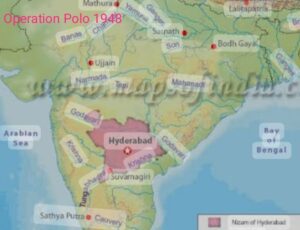
2. Operation Polo 1948 : Causes of Operation Polo
• Discuss the political factors leading to Operation Polo.
Operation Polo in 1948, which resulted in the annexation of Hyderabad into the Indian Union, was driven by a complex set of political factors. These factors highlighted the tensions and conflicts between the Nizam’s princely state of Hyderabad and the newly independent Indian government led by figures like Sardar Patel. Here are the key political factors leading to Operation Polo:
1.The Nizam’s Reluctance to Accede: The Nizam of Hyderabad, Mir Osman Ali Khan, was initially hesitant to accede to either India or Pakistan after independence. He expressed his desire to maintain Hyderabad’s independence as a sovereign state, despite being geographically surrounded by India. This stance raised concerns in New Delhi about the potential for a hostile, uncooperative neighbor in the heart of India.
2.Communal Tensions: Hyderabad had a significant Hindu population, and communal tensions had simmered for years. The Nizam’s administration was accused of favoring Muslims in matters of governance, leading to grievances among the Hindu population. This communal divide added a layer of complexity to the political landscape.
3.Accession of Other Princely States: By 1948, most of India’s princely states had acceded to the Indian Union, following negotiations and agreements with leaders like Sardar Patel. The Nizam’s reluctance to follow suit created a situation where Hyderabad remained an outlier in the process of integration.
4.Geopolitical Concerns: Hyderabad’s geographical location made it strategically important. Its proximity to the newly formed state of India raised concerns about security, as a hostile state in the middle of India could potentially disrupt the country’s territorial integrity.
5.India’s Stand on Princely States: The Indian government, led by figures like Sardar Patel and Jawaharlal Nehru, was committed to the idea of a unified India. They believed that the integration of princely states was essential for the nation’s stability and progress. Patel, in particular, pursued a policy of persuasion and negotiation with princely states to accede to India.
6.Lack of Cooperation: Negotiations between the Indian government and the Nizam’s administration were marred by a lack of cooperation. The Nizam’s government was accused of stalling and not taking steps toward integration, fueling suspicions of separatist tendencies.
7.Public Sentiment: The people of Hyderabad, both Hindu and Muslim, increasingly expressed their desire to accede to India. Mass protests and demonstrations for integration with India became more frequent, reflecting the popular sentiment in favor of joining the Indian Union.
8.International Pressure: The international community, including the United States and the United Kingdom, supported India’s stance on the integration of princely states. This diplomatic pressure further isolated the Nizam’s administration.
In this tense political environment, Operation Polo was launched in September 1948 by the Indian government. The military campaign swiftly resulted in the surrender of the Nizam’s forces and the integration of Hyderabad into the Indian Union. This operation marked a crucial step in India’s post-independence history, underlining the government’s determination to bring all princely states into the fold of the newly formed Republic of India.
• Mention the tensions between the Indian government and the Nizam.
The tensions between the Indian government and the Nizam of Hyderabad in the lead-up to Operation Polo were multifaceted and deeply rooted in political, communal, and administrative issues. These tensions contributed significantly to the eventual military action. Here are some of the key points highlighting the strained relationship:
1. Reluctance to Accede: The Nizam, Mir Osman Ali Khan, was initially hesitant to accede to either India or Pakistan after independence in 1947. His reluctance to make a decision created uncertainty and suspicion about his intentions. The Indian government viewed this as a challenge to the process of integrating princely states into the newly independent nation.
2.Communal Favoritism: The Nizam’s administration was accused of favoring Muslims in various aspects of governance, leading to grievances among the Hindu population. This perceived communal bias created deep-seated mistrust and heightened communal tensions within the princely state.
3.Law and Order Issues: Hyderabad faced persistent law and order problems, often linked to communal violence and political unrest. The Indian government was concerned about maintaining peace and stability in the region and believed that a lack of cooperation from the Nizam’s administration was exacerbating these issues.
4.Role of Razakars: The Razakar militia, a paramilitary organization in Hyderabad, was seen as a tool of the Nizam’s government. The Razakars were accused of using force and intimidation against those advocating for Hyderabad’s integration with India. Their actions added to the atmosphere of fear and mistrust.
5.Accession Negotiations: Negotiations between the Nizam’s representatives and the Indian government, particularly Sardar Patel, were marked by a lack of progress. The Nizam’s side was perceived as stalling and not taking concrete steps toward accession, further fueling suspicions about separatist intentions.
6.Popular Sentiment: The people of Hyderabad, both Hindus and Muslims, increasingly expressed their desire to accede to India. Mass protests and demonstrations for integration with India reflected the popular sentiment in favor of joining the Indian Union. The Nizam’s government’s reluctance to heed this sentiment deepened the divide.
7.Geopolitical Concerns: Hyderabad’s geographical location, surrounded by Indian territory, raised security concerns for the Indian government. The possibility of a hostile, uncooperative neighbor in the middle of India was seen as a threat to the nation’s territorial integrity.
8.International Diplomacy: The Indian government garnered international support for its stance on the integration of princely states. This diplomatic pressure further isolated the Nizam’s administration on the international stage, making it increasingly untenable for Hyderabad to maintain an independent stance.
These tensions came to a head in September 1948 when Operation Polo was launched by the Indian government, resulting in the swift surrender of the Nizam’s forces and the integration of Hyderabad into the Indian Union. Operation Polo marked the resolution of these tensions and the end of the Nizam’s rule in Hyderabad, ushering in a new chapter in the history of the region.
• Explain how communal violence added to the conflict.
Communal violence played a significant role in adding to the conflict between the Indian government and the Nizam of Hyderabad in the lead-up to Operation Polo. Communal violence refers to violence and clashes between different religious communities, often along religious lines. In the case of Hyderabad, this communal violence primarily involved the Hindu and Muslim communities and exacerbated existing tensions. Here’s how communal violence contributed to the conflict:
1.Religious Divide: Hyderabad had a diverse population comprising both Hindus and Muslims, among other religious groups. However, historical factors, including the Nizam’s rule and administrative policies, had created a religious divide within the princely state. Hindus and Muslims often lived in separate areas, and communal mistrust had festered over the years.
2.Communal Riots: Communal riots had erupted in Hyderabad even before India’s independence in 1947. These clashes were often sparked by religious differences, economic disparities, and political factors. The communal riots resulted in loss of life, property, and deep-seated animosity between the two communities.
3.Role of Militias: The Nizam’s government had sanctioned the formation of militias like the Razakars, which were perceived as pro-Muslim and responsible for instigating violence against the Hindu population. The Razakars’ actions included attacks, intimidation, and forced conversions, leading to a significant escalation of communal tensions.
4.Political Exploitation: Both the Nizam’s administration and elements within the princely state’s political leadership sometimes exploited communal divisions for political gain. This further polarized communities and made reconciliation more challenging.
5.Mass Displacement: Communal violence led to mass displacement of populations, with Hindus and Muslims fleeing from areas where they were in the minority. This displacement added to the humanitarian crisis and heightened tensions.
6.Public Sentiment: The communal violence galvanized public sentiment on both sides. Hindu and Muslim communities increasingly aligned with their respective causes, with Hindus generally favoring accession to India and Muslims, particularly the Razakars, advocating for Hyderabad’s independence.
7.International Perception: The communal violence in Hyderabad drew international attention and raised concerns about religious conflict in the region. This international scrutiny influenced diplomatic efforts to resolve the crisis.
8.Impact on Negotiations: The communal violence complicated negotiations between the Indian government and the Nizam’s representatives. The Indian government viewed the violence as a sign that Hyderabad’s accession was essential to restore peace and protect the interests of all communities.
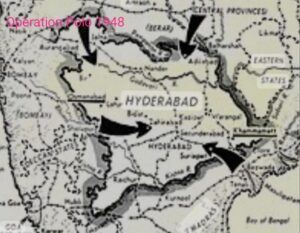
3. Operation Polo 1948 : The Role of Sardar Patel
• Highlight Sardar Patel’s efforts to integrate princely states.
Sardar Patel, as India’s first Deputy Prime Minister and Minister of Home Affairs, played a pivotal role in integrating princely states into the newly independent India. Through diplomacy, negotiations, and persuasion, he successfully convinced most princely rulers to accede to India, fostering national unity and territorial integrity during a critical period in Indian history.
• Discuss his negotiations with the Nizam.
Sardar Vallabhbhai Patel’s negotiations with the Nizam of Hyderabad, Mir Osman Ali Khan, were a critical aspect of his efforts to integrate princely states into India. Here’s an overview of his negotiations with the Nizam:
1.Diplomatic Approach: Patel adopted a diplomatic approach in his dealings with the Nizam. He recognized the complex political and communal dynamics in Hyderabad and sought a peaceful resolution through negotiations.
2.Letters and Correspondence: Patel initiated correspondence with the Nizam to persuade him to accede to India. In these letters, he outlined the benefits of integration, including security, economic development, and political stability.
3.Negotiation Teams: Patel appointed V.P. Menon as his principal envoy to negotiate with the Nizam’s representatives. Menon was instrumental in conducting face-to-face discussions and addressing concerns raised by the Nizam’s administration.
4.Religious and Communal Considerations: Patel was sensitive to the religious and communal aspects of the issue. He assured the Nizam that religious and cultural rights of the Muslim population in Hyderabad would be protected within the Indian Union.
5.Economic Incentives: Patel emphasized the economic advantages of accession. He argued that Hyderabad would benefit from India’s economic development and access to national resources.
6.Security Concerns: Patel highlighted the security risks posed by the continued standoff between Hyderabad and the Indian government. He stressed the need for cooperation to maintain peace and stability in the region.
7.International Diplomacy: Patel leveraged international diplomatic pressure to influence the Nizam’s decision. The international community, including the United States and the United Kingdom, supported India’s stance on integrating princely states.
8.Deadlines and Ultimatum: As negotiations progressed slowly, Patel issued an ultimatum, urging the Nizam to make a swift decision on accession. This deadline added urgency to the negotiations.
9.Operational Polo: When negotiations failed to yield the desired outcome and tensions escalated due to communal violence, Patel sanctioned Operation Polo, a military campaign aimed at integrating Hyderabad into India. The operation ultimately led to the surrender of the Nizam’s forces and Hyderabad’s accession to India in September 1948.
Sardar Patel’s firm but diplomatic approach, coupled with strategic negotiations, showcased his determination to bring Hyderabad into the Indian Union. His efforts not only resolved the long-standing issue of Hyderabad’s status but also contributed significantly to the successful integration of other princely states into the newly formed Republic of India.
• Explain Patel’s strategy in dealing with Hyderabad.
Sardar Patel‘s strategy in dealing with Hyderabad involved a combination of diplomacy, persuasion, and, when necessary, firmness. He emphasized the benefits of accession, addressed communal concerns, utilized international pressure, and set deadlines to influence the Nizam’s decision. This multi-faceted approach aimed at peacefully integrating Hyderabad into the Indian Union.
4. Operation Polo 1948 : The Military Campaign
• Describe the Indian military’s involvement.
The Indian military’s involvement in Operation Polo, the military campaign leading to the integration of Hyderabad into the Indian Union in 1948, was a crucial aspect of the operation. Here’s a description of the Indian military’s role:
• Deployment of Troops: The Indian government, under the leadership of Sardar Patel, deployed a significant number of Indian Army troops to the Hyderabad border in preparation for the operation.
• Objective: The primary objective of the military operation was to compel the Nizam’s government to accede to India and end the standoff between Hyderabad and the Indian Union peacefully.
• Strategic Planning: The military campaign was carefully planned to minimize casualties and damage. A well-coordinated strategy was developed to achieve the objectives swiftly and efficiently.
•Key Battles: The operation involved key battles and engagements, including the Battle of Adilabad, Battle of Naldurg, and the capture of key towns like Aurangabad and Bidar. These battles played a significant role in securing Hyderabad’s integration.
• Surrender of Nizam’s Forces: The Indian military’s advance and successful engagements led to the surrender of the Nizam’s forces, effectively ending the resistance against accession.
• Restoration of Law and Order: After the surrender, the Indian military took on the responsibility of restoring law and order in Hyderabad and ensuring the safety of the population.
• Integration Process: With the military’s role complete, the process of integrating Hyderabad into the Indian Union commenced. Administrative and political measures were put in place to facilitate this transition.
• Humanitarian Efforts: The Indian military also engaged in humanitarian efforts, providing relief and support to the civilian population affected by the conflict.
Operation Polo marked a successful military campaign that resolved the long-standing issue of Hyderabad’s status within the Indian Union. The Indian military’s professionalism and strategic execution played a vital role in achieving the operation’s objectives and bringing Hyderabad into the fold of the newly formed Republic of India.
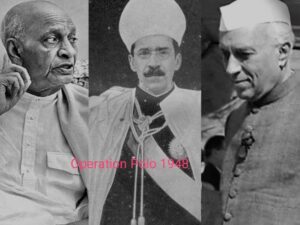
• Explain the objectives and challenges of Operation Polo.
Operation Polo, launched in September 1948, had specific objectives and faced various challenges as it aimed to integrate Hyderabad into the Indian Union. Here’s a breakdown of its objectives and challenges:
1. Objectives:
• Integration: The primary objective was to integrate the princely state of Hyderabad, ruled by the Nizam, into the newly independent Republic of India. This was in line with the broader goal of unifying India’s princely states into a single nation.
• End Communal Violence: Another key objective was to put an end to the communal violence and tensions that had plagued Hyderabad for years. The operation sought to restore peace and stability in the region.
• Prevent Secession: Operation Polo aimed to prevent the Nizam from pursuing an independent path or aligning Hyderabad with Pakistan. Ensuring that Hyderabad remained part of India was crucial for national security and territorial integrity.
• Secure Accession: The operation sought to secure the Nizam’s formal accession to India. This involved dismantling resistance, compelling the Nizam’s government to accede, and ensuring a smooth transition of authority to Indian administration.
• Humanitarian Goals: Operation Polo also had humanitarian goals, including protecting the rights and safety of the civilian population, regardless of their religious or communal affiliations.
2. Challenges:
• Military Logistics: The operation faced logistical challenges in terms of deploying and supplying Indian Army units over long distances to reach Hyderabad’s borders. This required careful planning and coordination.
• Communal Sensitivities: Communal tensions were deeply ingrained in Hyderabad, and addressing these sensitivities without further exacerbating them was a significant challenge. The operation had to be executed in a way that minimized the risk of communal violence.
• International Scrutiny: The international community closely monitored the situation in Hyderabad. Balancing the need for swift action with international perceptions and diplomatic pressures was challenging.
• Political Resistance: The Nizam’s government and certain elements within Hyderabad resisted accession to India. Overcoming this political resistance while avoiding an all-out conflict was a delicate task.
• Ensuring Minimal Casualties: Operation Polo aimed to minimize casualties among both Indian Army personnel and the civilian population. Achieving this while effectively ending resistance was a complex challenge.
• Humanitarian Concerns: The operation had to address the humanitarian needs of displaced populations and civilians affected by the conflict.
Despite these challenges, Operation Polo ultimately succeeded in achieving its objectives. The Nizam’s forces surrendered, Hyderabad was integrated into India, and a process of stabilization and reconciliation began in the region. The operation remains a significant chapter in India’s post-independence history.
• Discuss key battles and milestones during the campaign.
Operation Polo, the military campaign that led to the integration of Hyderabad into the Indian Union in 1948, featured several key battles and milestones. These engagements played a crucial role in achieving the campaign’s objectives. Here are some of the notable battles and milestones:
1.Announcement of Operation Polo (September 13, 1948): The Indian government, led by Sardar Patel, formally announced Operation Polo, signaling its intent to resolve the Hyderabad issue militarily if necessary.
2.Military Advance and Surrounding of Hyderabad: Indian Army units began advancing towards Hyderabad from multiple directions, surrounding the city and isolating the Nizam’s forces.
3.Battle of Adilabad: Adilabad was one of the first significant towns to be captured by Indian forces. This early victory boosted Indian morale and marked the beginning of the campaign.
4.Battle of Aurangabad: Aurangabad was a strategically important city in the Nizam’s dominion. Indian forces engaged in fierce battles to capture the city, eventually succeeding.
5.Battle of Bidar: Bidar, known for its historical significance, witnessed a crucial battle. The capture of Bidar was a milestone in advancing towards the heart of Hyderabad.
6.Battle of Naldurg: Naldurg, a town of strategic importance, witnessed intense fighting. The Indian Army’s success in capturing Naldurg further weakened the Nizam’s resistance.
7.Surrender of Nizam’s Forces (September 17, 1948): Faced with the overwhelming advance of Indian forces and recognizing the futility of resistance, the Nizam’s forces surrendered. This marked a significant turning point in the campaign.
8.Accession of Hyderabad to India (September 17, 1948): With the surrender of the Nizam’s forces, the Nizam formally signed the Instrument of Accession, integrating Hyderabad into the Indian Union.
9.End of the Razakar Movement: The surrender of the Nizam’s forces also led to the disbandment of the Razakar militia, which had played a crucial role in supporting the Nizam’s government.
10.Establishment of Indian Administration: With Hyderabad’s accession to India, Indian administrators took charge of the state, marking the beginning of the process of integration and the restoration of law and order.
11.Transition to Peace: Following the military campaign, efforts were made to restore peace, rehabilitate displaced populations, and address communal tensions. These efforts were crucial in stabilizing the region.
12.Formation of Andhra Pradesh: Hyderabad’s integration paved the way for the reorganization of states in India. In 1956, Andhra Pradesh was formed, with Hyderabad as its capital.
These battles and milestones in Operation Polo demonstrated the effectiveness of the Indian military in achieving its objectives. The campaign’s success led to the integration of Hyderabad into India, helping to stabilize the region and solidify the principles of unity and territorial integrity in the newly independent nation.
5. Operation Polo 1948 : Outcome and Integration
• Explain the eventual surrender of the Nizam’s forces.
The eventual surrender of the Nizam’s forces during Operation Polo in 1948 was primarily a result of the overwhelming advance and superior firepower of the Indian Army. Faced with the determined and well-organized Indian military campaign, the Nizam’s forces recognized the futility of continued resistance. On September 17, 1948, the Nizam’s forces formally surrendered, marking a pivotal moment in the campaign. This surrender paved the way for the Nizam to sign the Instrument of Accession, integrating Hyderabad into the Indian Union and bringing an end to the military conflict.
• Describe the integration of Hyderabad into the Indian Union.
The integration of Hyderabad into the Indian Union, following Operation Polo in 1948, was a complex process that involved various administrative, political, and social measures. Here’s a description of the key steps and aspects of this integration:
1.Signing of the Instrument of Accession: After the surrender of the Nizam’s forces, Mir Osman Ali Khan, the Nizam of Hyderabad, signed the Instrument of Accession, officially merging Hyderabad into the newly independent Republic of India. This document formalized the state’s alignment with the Indian Union, particularly in matters of defense, foreign affairs, and communication.
2.Establishment of Indian Administration: With the signing of the Instrument of Accession, Indian administrators took charge of the state’s administration. The transition to Indian governance was a critical step in the integration process.
3.Restoration of Law and Order: Ensuring peace and stability was a top priority. The Indian government, with the help of the Indian Army, worked to restore law and order in Hyderabad, quelling any remaining pockets of resistance and violence.
4.Disbandment of Paramilitary Groups: One of the challenges during Operation Polo had been the presence of paramilitary groups like the Razakars. Following the integration, these groups were disbanded to prevent further unrest.
5.Rehabilitation of Displaced Populations: Communal violence and the military campaign had led to the displacement of populations. Efforts were made to provide humanitarian assistance and rehabilitate those affected by the conflict.
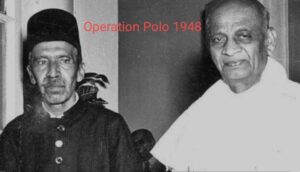
6.Formation of Administrative Structures: Indian administrative structures were established to govern Hyderabad effectively. This included appointing civil servants, law enforcement agencies, and other administrative bodies to oversee the region.
7.Political Integration: Hyderabad’s political integration involved the merging of its political institutions and processes with those of the Indian Union. This included transitioning to democratic governance and participation in Indian elections.
8.Language and Cultural Preservation: The Indian government was sensitive to Hyderabad’s linguistic and cultural diversity. Efforts were made to preserve and promote the region’s languages, culture, and traditions within the framework of the Indian Union.
9.Economic Development: Hyderabad’s integration brought economic benefits, as it gained access to national resources and development initiatives. This helped stimulate economic growth and development in the region.
10.Reorganization of States: Hyderabad’s integration had broader implications for the reorganization of states in India. In 1956, Andhra Pradesh was formed, with Hyderabad as its capital, marking a significant political change.
The integration of Hyderabad into the Indian Union was a crucial step in India’s post-independence history. It demonstrated the Indian government’s commitment to national unity and the principles of democracy. While challenges and complexities existed, the successful integration of Hyderabad contributed to the stability and development of the region and strengthened India’s territorial integrity.
• Discuss the aftermath and changes in governance.
The aftermath of Hyderabad’s integration into the Indian Union brought about significant changes in governance and had far-reaching implications:
1.End of Nizam’s Rule: The integration marked the end of the Nizam’s rule in Hyderabad, with Indian administrators taking over the governance of the state.
2.Transition to Democracy: Hyderabad transitioned from a princely state to a democratic entity within the Indian Union. Elections were held, and representative governments were established at the state and local levels.
3.Administrative Reforms: Indian administrative structures were introduced, ensuring uniformity and efficiency in governance. This included the establishment of government departments, police forces, and other administrative bodies.
4.Maintenance of Law and Order: Efforts were made to restore and maintain law and order, quelling any residual unrest and ensuring the safety of the population.
5.Cultural Preservation: The Indian government promoted and preserved the linguistic and cultural diversity of Hyderabad, recognizing its rich heritage and traditions.
6.Economic Development: Hyderabad gained access to national resources and development initiatives, leading to economic growth and infrastructural development in the region.
7.Political Reorganization: The integration process contributed to the reorganization of states in India. In 1956, Andhra Pradesh was formed, with Hyderabad as its capital, reshaping the political landscape of South India.
8.Communal Harmony: The integration aimed to restore communal harmony and reduce tensions that had plagued Hyderabad for years. Efforts were made to foster tolerance and understanding among diverse communities.
9.Strengthened Territorial Integrity: Hyderabad’s integration solidified India’s territorial integrity, as it brought an end to a significant political anomaly in the heart of the country.
10.National Unity: The successful integration of Hyderabad into the Indian Union reinforced the principles of national unity and the indivisibility of India, a crucial aspect of the country’s post-independence identity.
In sum, the aftermath of Hyderabad’s integration witnessed a transition from princely rule to democratic governance, along with significant reforms in administration, economy, and culture. These changes contributed to the region’s development and played a pivotal role in shaping the political and social landscape of South India.
6. Operation Polo 1948 : Legacy and Impact
• Discuss the long-term consequences of Operation Polo.
Operation Polo, resulting in the integration of Hyderabad into India, had long-term consequences. It strengthened India’s territorial integrity, reinforced the principles of national unity, and promoted communal harmony. The successful operation set a precedent for resolving princely state issues, contributing to the stability and diversity of modern India.
• Explain its significance in shaping post-independence India.
Operation Polo’s significance in shaping India’s post-independence history is profound:
1.Territorial Integrity: It reaffirmed India’s commitment to maintaining its territorial integrity and sovereignty, preventing the creation of potentially disruptive independent entities within its borders.
2.Unity in Diversity: The successful integration of Hyderabad showcased India’s ability to manage diversity and complex regional dynamics while maintaining national unity.
3.Princely States Integration: Operation Polo served as a template for peacefully integrating other princely states into India, thereby solidifying the newly formed Republic’s geographic unity.
4.Communal Harmony: By addressing longstanding communal tensions, it contributed to the promotion of communal harmony and coexistence in a diverse nation.
5.Democratic Governance: Hyderabad’s transition from princely rule to democratic governance demonstrated India’s commitment to democratic principles and practices.
6.Geopolitical Stability: It helped establish India as a stable and dependable regional power, influencing the geopolitics of South Asia.
7.National Identity: The operation reinforced India’s identity as a secular, democratic, and unified nation.
Overall, Operation Polo’s success played a crucial role in shaping India’s identity, territorial boundaries, and democratic foundations in the tumultuous period following independence.
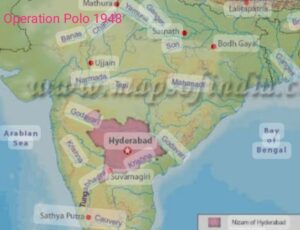
• Mention the impact on Hyderabad’s cultural and political landscape.
Operation Polo had a profound impact on Hyderabad’s cultural and political landscape:
1.Cultural Impact:
• Diverse Heritage: Hyderabad’s cultural landscape remained diverse, with influences from Hindu, Muslim, and Telugu traditions. The city continued to celebrate its rich heritage, including its culinary diversity, festivals, and arts.
• Language: Telugu remained a prominent language, and the Telugu-speaking population continued to contribute to the state’s cultural vibrancy.
• Historical Monuments: The city’s historical monuments, including the Charminar and Golconda Fort, continued to stand as iconic symbols of its cultural heritage.
2. Political Impact:
• Integration into Indian Union: Politically, Hyderabad was fully integrated into the Indian Union, becoming part of the Indian democratic system.
• State Reorganization: The integration led to the reorganization of states in India. In 1956, Andhra Pradesh was formed, with Hyderabad as its capital, altering the state’s political landscape.
• End of Princely Rule: The Nizam’s rule came to an end, and the governance transitioned to Indian democratic institutions, marking a significant political shift.
• Communal Harmony: Efforts were made to address communal tensions, fostering a more harmonious coexistence among different communities.
Overall, Operation Polo’s impact on Hyderabad’s cultural and political landscape reflected a continuation of its diverse heritage within the framework of the Indian Union, while also leading to significant political changes
integration into India’s democratic system.
Conclusion :
Operation Polo 1948 was a watershed moment in India’s post-independence history. It successfully integrated Hyderabad, a princely state with complex communal and political dynamics, into the Indian Union. This military operation demonstrated India’s commitment to territorial integrity, communal harmony, and democratic governance. Its historical significance lies in shaping the nation’s identity, unity, and ability to peacefully resolve complex regional challenges.
FAQs :
1. Who led the Operation Polo during 1948?
2. What is Operation Polo in history?
3. Why was Operation Polo launched?
4. Which state was involved in Operation Polo?
5. Operation polo 1948 wikipedia
6. Operation polo 1948 upsc
7.Operation polo 1948 notes

